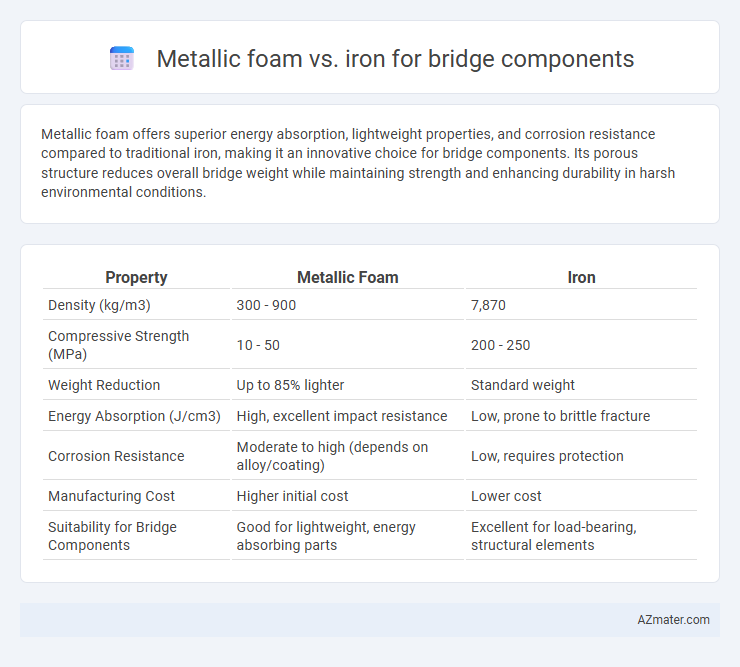Metallic foam offers superior energy absorption, lightweight properties, and corrosion resistance compared to traditional iron, making it an innovative choice for bridge components. Its porous structure reduces overall bridge weight while maintaining strength and enhancing durability in harsh environmental conditions.
Table of Comparison
| Property | Metallic Foam | Iron |
|---|---|---|
| Density (kg/m3) | 300 - 900 | 7,870 |
| Compressive Strength (MPa) | 10 - 50 | 200 - 250 |
| Weight Reduction | Up to 85% lighter | Standard weight |
| Energy Absorption (J/cm3) | High, excellent impact resistance | Low, prone to brittle fracture |
| Corrosion Resistance | Moderate to high (depends on alloy/coating) | Low, requires protection |
| Manufacturing Cost | Higher initial cost | Lower cost |
| Suitability for Bridge Components | Good for lightweight, energy absorbing parts | Excellent for load-bearing, structural elements |
Introduction to Bridge Material Selection
Metallic foam offers a high strength-to-weight ratio and superior energy absorption compared to traditional iron, making it an innovative option for bridge components. Iron, known for its durability and cost-effectiveness, remains a common material but lacks the lightweight and damping properties of metallic foam. Selecting materials for bridge construction involves balancing structural integrity, weight, corrosion resistance, and long-term maintenance requirements.
Overview of Metallic Foam and Iron
Metallic foam, characterized by its porous structure and high strength-to-weight ratio, offers superior energy absorption and corrosion resistance compared to traditional iron, making it suitable for innovative bridge components. Iron, with its dense atomic structure, provides excellent load-bearing capacity and durability but tends to be heavier and more susceptible to rust without protective coatings. The choice between metallic foam and iron depends on specific bridge requirements for weight reduction, structural integrity, and environmental durability.
Mechanical Properties Comparison
Metallic foam offers superior energy absorption and lightweight characteristics compared to traditional iron, significantly reducing the overall structural weight of bridge components. Iron exhibits higher tensile strength and stiffness, making it suitable for load-bearing applications requiring durability and resistance to deformation. The choice between metallic foam and iron depends on balancing weight reduction with mechanical performance requirements in bridge design.
Weight and Density Differences
Metallic foam exhibits significantly lower density compared to solid iron, offering lightweight structural advantages essential for bridge components. With densities ranging from 0.4 to 0.8 g/cm3, metallic foam is substantially lighter than iron, which has a density of approximately 7.87 g/cm3. This weight reduction enhances load efficiency and reduces overall bridge mass without compromising strength and durability.
Structural Strength and Load-Bearing Capacity
Metallic foam exhibits significantly lower density compared to traditional iron, offering enhanced specific strength that benefits weight-sensitive bridge components. While iron provides superior absolute structural strength and higher load-bearing capacity, metallic foam compensates with excellent energy absorption and resistance to fatigue under dynamic loads. The integration of metallic foam in bridge structures can improve overall performance by reducing dead weight without severely compromising load-bearing capabilities.
Corrosion Resistance and Durability
Metallic foam exhibits superior corrosion resistance compared to traditional iron due to its porous structure coated with protective alloys, reducing oxidation rates in bridge components. This enhanced corrosion resistance translates into prolonged durability, minimizing maintenance needs and extending the service life of structural elements. Iron, while strong, is more susceptible to rust and degradation under environmental stress, making metallic foam a preferable choice for long-term infrastructure resilience.
Fabrication and Installation Challenges
Metallic foam presents fabrication challenges due to its porous structure, requiring specialized casting techniques and precise control of pore size to maintain structural integrity, unlike iron which benefits from well-established forging and welding processes. Installation of metallic foam components demands careful handling to prevent damage from impact or compressive forces, whereas iron components offer greater robustness and ease of modification on-site. The lightweight nature of metallic foam reduces installation time and labor costs but complicates alignment and fastening procedures compared to traditional iron elements.
Cost Efficiency and Lifecycle Analysis
Metallic foam offers significant cost efficiency for bridge components due to its lightweight nature, reducing transportation and installation expenses compared to traditional iron. Lifecycle analysis reveals that metallic foam's high corrosion resistance and energy absorption capabilities enhance durability and reduce maintenance costs over time. While iron provides superior initial strength, metallic foam's extended service life and lower long-term expenses make it a competitive alternative for sustainable bridge construction.
Environmental Impact and Sustainability
Metallic foam offers significantly lower environmental impact than traditional iron in bridge components due to its lighter weight, which reduces material consumption and transportation emissions. The high porosity of metallic foam enhances energy absorption and corrosion resistance, leading to longer service life and decreased maintenance, thereby supporting sustainability. In contrast, iron's higher density and vulnerability to corrosion result in increased resource use and environmental degradation over the bridge's lifecycle.
Future Trends in Bridge Component Materials
Metallic foam offers superior energy absorption and corrosion resistance compared to traditional iron, making it a promising material for future bridge components. Advances in additive manufacturing enable the precise tailoring of metallic foam structures to optimize strength-to-weight ratios, enhancing durability and reducing maintenance costs. Emerging trends indicate increased integration of metallic foam composites to achieve lightweight, sustainable, and resilient bridge designs.

Infographic: Metallic foam vs Iron for Bridge component
 azmater.com
azmater.com